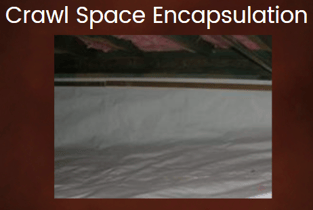Unveiling the Mystery: Crawl Space Encapsulation vs. Crawl Space Lining

Intro: When it comes to crawl spaces, many homeowners tend to overlook their significance. After all, it's an area hidden beneath your home, out of sight and often out of mind. However, understanding how to properly care for your crawl space is crucial for maintaining a healthy and structurally sound home. In this blog, we'll delve into why homeowners may not investigate the best ways to protect their crawl spaces and explore the key differences between crawl space encapsulation and crawl space lining.
Why Don't Homeowners Investigate Crawl Space Solutions? Homeowners often neglect their crawl spaces for several reasons:
-
Lack of Awareness: Many people aren't aware of the importance of crawl spaces and their impact on indoor air quality and structural integrity.
-
Out of Sight, Out of Mind: Crawl spaces are typically hidden from view, making it easy to forget about them until issues arise.
-
Myths and Misconceptions: Common misconceptions, such as believing that crawl space problems won't affect the rest of the home, can deter homeowners from seeking solutions.
-
DIY Challenges: Crawl space projects can be challenging and labor-intensive, deterring homeowners from tackling them on their own.
What is Crawl Space Encapsulation?
Crawl space encapsulation is a comprehensive method used to seal and protect a crawl space underneath a home or building. It involves creating a sealed and conditioned environment by covering the crawl space floor, walls, and sometimes even the ceiling with various materials, such as vapor barriers, insulation, and sealing tapes. Here's how crawl space encapsulation works:
-
Moisture Control: The process begins with addressing moisture issues. Any standing water or excess moisture is removed, and drainage systems may be installed to prevent water intrusion. This step is crucial for preventing mold, mildew, and wood rot.
-
Vapor Barrier Installation: A thick, durable vapor barrier or crawl space liner is installed on the crawl space floor. This barrier acts as a moisture barrier, preventing ground moisture from rising into the crawl space.
-
Wall and Ceiling Encapsulation: In some cases, the crawl space walls and ceiling are also covered with vapor barriers or insulation. This provides a complete seal and ensures that no moisture or outside air can enter the space.
-
Sealing Gaps and Vents: Any gaps, cracks, or openings in the crawl space are sealed to prevent outside air, pests, and moisture from entering. Crawl space vents may be sealed or equipped with vent covers to further prevent air exchange.
-
Dehumidification: In humid climates or areas with high moisture levels, a crawl space dehumidifier may be installed to maintain ideal humidity levels within the encapsulated space.
-
Insulation: Depending on local climate conditions, insulation may be added to the crawl space walls to improve energy efficiency and maintain stable indoor temperatures.
-
Air Quality Improvement: Crawl space encapsulation also contributes to improved indoor air quality by preventing the entry of allergens, mold spores, and pollutants from the crawl space into the living areas of the home.
In Summary: Understanding the importance of crawl spaces and the differences between crawl space encapsulation and lining is crucial for homeowners. While lining provides a moisture barrier, encapsulation offers a more comprehensive solution that addresses moisture control, insulation, ventilation, and air quality, resulting in a healthier and more energy-efficient home. Don't neglect your crawl space; explore the best options for your home's well-being.
Do you want to learn more about crawl space vapor barrier/ liners? There are different types. Visit the product page here.
Learn more by calling the company that supplies the crawl space liners to installers. Then decide if you want to do it yourself or call a crawl sapce professional.


